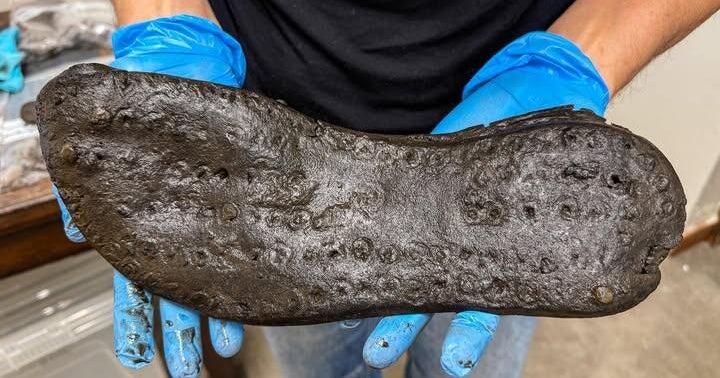Archaeologists in northern England have unearthed an extraordinary collection of ancient shoes, dating back approximately 2,000 years, at the Magna Roman Fort site. Among the eight uncovered shoes, one measures nearly 13 inches, making it a historical record for size. This unexpected discovery has prompted researchers to investigate the significance of these unusually large artifacts, which could reveal insights into the people and life at this Roman site.
| Article Subheadings |
|---|
| 1) Discovery of the Ancient Shoes |
| 2) Significance of Size |
| 3) Historical Context of Magna Roman Fort |
| 4) The Archaeological Process |
| 5) Broader Implications of the Findings |
Discovery of the Ancient Shoes
The finding of the large shoes happened at the Magna Roman Fort, located in Northumberland, a site rich in Roman history. Archaeologists from the Vindolanda Charity Trust made the discovery during ongoing excavations that aim to unearth and preserve Roman remains since the Trust’s establishment in 1970. The excavation team first reported uncovering an “exceptionally large shoe” on May 21, 2023, and continued to find more over subsequent months.
The shoes were excavated from a defensive ditch at the fort, a common Roman practice where such ditches served as rubbish dumps. This find is particularly compelling because the size of the shoes differs significantly from other artifacts found at similar sites. The contrasting dimensions raise questions about who wore the shoes and what these findings indicate about the demographic diversity present at Magna.
Significance of Size
The shoes vary significantly in size, with the largest measuring approximately 32.6 cm, marking a record for the Vindolanda Trust’s collection. Rachel Frame, a senior archaeologist involved in the project, pointed out that only a limited number of shoes in the existing collection match this extraordinary size. Interestingly, around 25% of the shoes unearthed from the Magna site fall into this larger category.
This unusual cluster of oversized footwear is raising questions within the archaeological community. Several theories are emerging regarding the wearer demographics for these shoes. Could they belong to a specific legion or division within the Roman military, or did they serve as a reflection of the cultural melting pot often associated with Roman settlements?
Historical Context of Magna Roman Fort
Magna, located near Hadrian’s Wall, served as a strategic military post for the Romans. The fort, part of the Roman Army’s extensive network, was inhabited by auxiliary troops—non-citizens who supported the Roman legions. It provides a unique glimpse into the daily lives of soldiers stationed in a remote frontier area.
The site holds immense archaeological significance, enabling researchers to piece together the interactions among various cultural groups during the height of the Roman Empire. Frame notes that the diverse constituents interacting at the site challenge the traditional Roman narrative often anchored solely in Italy.
The Archaeological Process
The excavation process at Magna requires specialized techniques to analyze the conditions under which these artifacts have survived for centuries. Dr. Elizabeth Greene, an expert from the University of Western Ontario, explained that the specific soil conditions at the site, characterized by low oxygen levels, create an environment where organic materials like wood and leather can remain preserved.
The team continues to encounter various organic materials, offering opportunities for more discoveries. In addition to the shoes, archaeologists recently unearthed a boxwood comb, adding further depth to the narrative being constructed around life at Magna. Each excavation adds layers of complexity to our understanding of this Roman site.
Broader Implications of the Findings
The discoveries at Magna have far-reaching implications. They not only enrich our knowledge of Roman life in Britain but also encourage a broader dialogue about the Empire’s vastness and diversity. Artifacts such as these shoes suggest that the Roman military was a complex, multicultural entity, transcending geographical boundaries.
Furthermore, the findings challenge existing perceptions about the physical characteristics of those in the Roman Army. The predominantly larger shoe sizes could indicate a need to accommodate a diverse population, perhaps reflecting changes in recruitment or settlement patterns within the Empire.
| No. | Key Points |
|---|---|
| 1 | A collection of large ancient shoes was discovered at Magna Roman Fort, dating back approximately 2,000 years. |
| 2 | The largest shoe measures 13 inches, revealing significant insights into the size variations within Roman footwear. |
| 3 | The discovery prompts questions regarding the demographics of those who wore the shoes and their cultural backgrounds. |
| 4 | The site’s rich soil conditions have enabled numerous organic artifacts to be preserved, paving the way for further archaeological exploration. |
| 5 | Overall implications suggest a multicultural Roman military presence in early Britain, challenging previously held notions of uniformity within the Empire. |
Summary
The unearthed shoes at the Magna Roman Fort tell a significant story of diversity and adaptation within the Roman military during its expansion into Britain. These artifacts not only serve as historical records but also as vital clues in exploring the complex socio-cultural fabric of the Roman Empire. As archaeologists continue to excavate and analyze this fascinating site, public interest in the Roman history of Britain is likely to rise, fostering a deeper understanding of its ancient inhabitants.
Frequently Asked Questions
Question: What is the significance of the large shoes found at Magna Roman Fort?
The large shoes signify potential demographic diversity among those stationed at Magna Roman Fort, prompting questions about who wore them and what this tells us about the Roman military in Britain.
Question: How were the shoes preserved over such a long period?
The shoes were preserved due to specific soil conditions at Magna, characterized by low oxygen levels, which create an optimal environment for organic materials like leather to survive through the centuries.
Question: What other artifacts have been found at the site?
In addition to the shoes, a boxwood comb has also been uncovered, showcasing the variety of organic artifacts that enrich the understanding of life at Magna Roman Fort.


